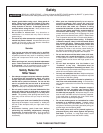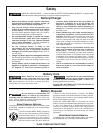
8
Getting To Know Your Miter Saw
Disconnect battery pack from tool
before performing any assembly,
adjustments, changing accessories, or storing the tool.
Such preventive safety measures reduce the risk of starting
the tool accidentally.
1. Carrying Handle
This handle is built into the head assembly for transportation.
2. Arbor Lock
Allows the user to keep the blade from rotating while
tightening or loosening arbor screw during blade replacement
or removal.
3. Safety Switch
The safety switch is designed to prevent accidental starts.
The release button must be depressed to activate the power
switch.
4. Switch Handle
This handle contains the switch. The blade is lowered into the
workpiece by pushing/pulling down on the handle.
5. Power Switch
The power switch used with the safety switch energizes the unit.
6. Lower Blade Guard/Lower Guard Lip
The lower blade guard helps protect your hands from the
spinning blade. It retracts as the blade is lowered. Lip can be
used to raise the lower guard when guard becomes jammed
on a workpiece.
7. Blade
For best performance, use only thin kerf 10” blades with 5/8”
arbor hole.
8. Fence
Supports the workpiece. The fence has a cast in scale to
make repetitive cuts easy. The fence also has holes which are
used to secure an auxiliary fence if desired.
9. Kerf Insert
Minimizes workpiece tear-out.
10. Tool Mounting Pads
The four corners of the saw provide areas to clamp, bolt or
nail the saw to a flat work surface.
11. Detent Override
Allows detent action to be locked out allowing for micro
adjustments to any miter angle.
1
6
3
5
4
7
8
8
9
10
10
11
12
13
14
15
16
17
17
18
21
19
20a
22
8
23
25
26
27
WARNIN
G
!
37
34
30
35
20


















